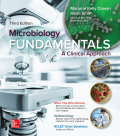
Introduction:
Infection is the whole process of entry of the disease-causing agents in the body of an organism, their multiplication and the production of toxins by them. Infections can be caused by bacteria, viruses, prions, nematodes, arthropods, and various other infectious agents.
Answer to Problem 1NP
Correct answer:
The progression of infection is promoted by the proper portal of entry, lack of previous exposure to infection, and host immunosuppression. Therefore, options (b), (d), and (e) are correct.
Option (b) is given as “proper portal of entry”, option (d) is given as “no previous exposure to this infection”, and option (e) is given as “host immunosuppression”.
Explanation of Solution
Justify reason for the correct statement:
The way through which infectious agent enters the body of the host is known as the portal of entry. This provides access to the tissues where infectious agents multiply. The portal of entry plays an important role, for example, influenza virus enters the respiratory tract through the inhalation of droplets.
Without prior exposure to the infection, the body does not have antibodies against this pathogen. It takes time to generate antibodies. The infectious agents take advantage of it and multiply at a faster rate.
Immuno-compromised and immune-suppressed individuals have a weak immune system which is not able to generate antibodies and fight against the disease. So infectious agents enter their body easily and infect different tissues.
Hence, options (b), (d), and (e) are correct.
Justify reasons for the incorrect statements:
Option (a) is given as “low microbial virulence”.
Virulence can be defined as the extent of damage that can be caused by any microbe. Low virulence refers to the low extent of the damage. This way, the pathogen cannot multiply within the body of hosts. Hence, it is a wrong answer.
Option (c) is given as “genetic profile of host resistance to microbe”.
Genetic profile of host resistance to infectious agent or microbe is not very important since the body of host responds to each of the microbes in its own manner and first exposure to the microbe is an example that genetic profile is not so important. Hence, it is a wrong answer.
Hence, options (a) and (c) are incorrect.
The progression of an infection depends on the correct portal of entry, no previous exposure to this infection, and host immunosuppression.
Want to see more full solutions like this?
Chapter 11 Solutions
Microbiology Fundamentals: A Clinical Approach
- Amino Acid Coclow TABle 3' Gly Phe Leu (G) (F) (L) 3- Val (V) Arg (R) Ser (S) Ala (A) Lys (K) CAG G Glu Asp (E) (D) Ser (S) CCCAGUCAGUCAGUCAG 0204 C U A G C Asn (N) G 4 A AGU C GU (5) AC C UGA A G5 C CUGACUGACUGACUGAC Thr (T) Met (M) lle £€ (1) U 4 G Tyr Σε (Y) U Cys (C) C A G Trp (W) 3' U C A Leu בוט His Pro (P) ££ (H) Gin (Q) Arg 흐름 (R) (L) Start Stop 8. Transcription and Translation Practice: (Video 10-1 and 10-2) A. Below is the sense strand of a DNA gene. Using the sense strand, create the antisense DNA strand and label the 5' and 3' ends. B. Use the antisense strand that you create in part A as a template to create the mRNA transcript of the gene and label the 5' and 3' ends. C. Translate the mRNA you produced in part B into the polypeptide sequence making sure to follow all the rules of translation. 5'-AGCATGACTAATAGTTGTTGAGCTGTC-3' (sense strand) 4arrow_forwardWhat is the structure and function of Eukaryotic cells, including their organelles? How are Eukaryotic cells different than Prokaryotic cells, in terms of evolution which form of the cell might have came first? How do Eukaryotic cells become malignant (cancerous)?arrow_forwardWhat are the roles of DNA and proteins inside of the cell? What are the building blocks or molecular components of the DNA and proteins? How are proteins produced within the cell? What connection is there between DNA, proteins, and the cell cycle? What is the relationship between DNA, proteins, and Cancer?arrow_forward
- please fill in the empty sports, thank you!arrow_forwardIn one paragraph show how atoms and they're structure are related to the structure of dna and proteins. Talk about what atoms are. what they're made of, why chemical bonding is important to DNA?arrow_forwardWhat are the structure and properties of atoms and chemical bonds (especially how they relate to DNA and proteins).arrow_forward
- The Sentinel Cell: Nature’s Answer to Cancer?arrow_forwardMolecular Biology Question You are working to characterize a novel protein in mice. Analysis shows that high levels of the primary transcript that codes for this protein are found in tissue from the brain, muscle, liver, and pancreas. However, an antibody that recognizes the C-terminal portion of the protein indicates that the protein is present in brain, muscle, and liver, but not in the pancreas. What is the most likely explanation for this result?arrow_forwardMolecular Biology Explain/discuss how “slow stop” and “quick/fast stop” mutants wereused to identify different protein involved in DNA replication in E. coli.arrow_forward
 Biology (MindTap Course List)BiologyISBN:9781337392938Author:Eldra Solomon, Charles Martin, Diana W. Martin, Linda R. BergPublisher:Cengage Learning
Biology (MindTap Course List)BiologyISBN:9781337392938Author:Eldra Solomon, Charles Martin, Diana W. Martin, Linda R. BergPublisher:Cengage Learning Microbiology for Surgical Technologists (MindTap ...BiologyISBN:9781111306663Author:Margaret Rodriguez, Paul PricePublisher:Cengage LearningEssentials of Pharmacology for Health ProfessionsNursingISBN:9781305441620Author:WOODROWPublisher:Cengage
Microbiology for Surgical Technologists (MindTap ...BiologyISBN:9781111306663Author:Margaret Rodriguez, Paul PricePublisher:Cengage LearningEssentials of Pharmacology for Health ProfessionsNursingISBN:9781305441620Author:WOODROWPublisher:Cengage





